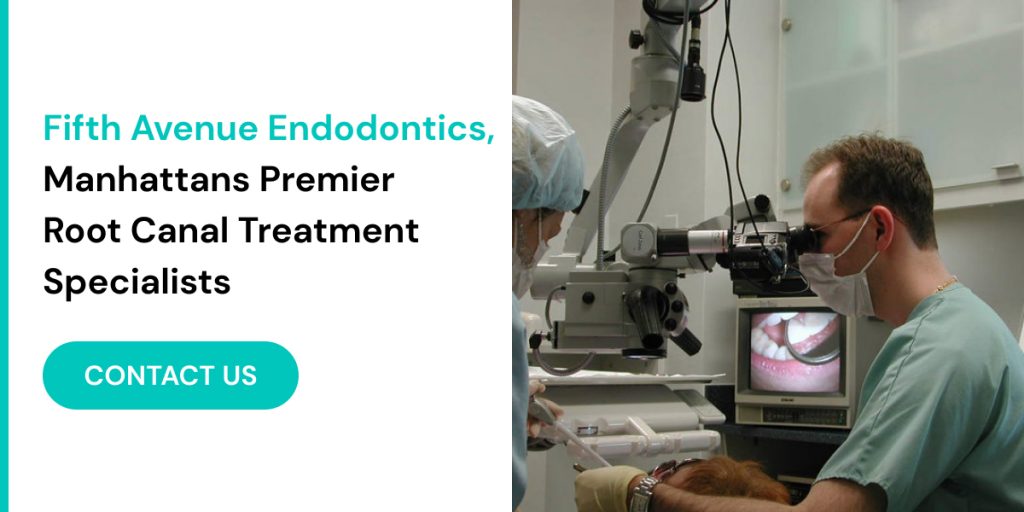Root canal treatment is a common dental procedure designed to save a tooth that is severely infected or decayed. The procedure involves removing the infected pulp, cleaning the inside of the tooth, and sealing it to prevent further infection. Despite the high success rate of this treatment, complications can occasionally arise. These complications can range from minor issues, such as temporary discomfort, to more serious problems that require additional intervention. Understanding these potential complications is crucial for both patients and dental professionals.
In the bustling heart of Manhattan, Fifth Avenue Endodontics, under the expert guidance of Dr. Iofin, has mastered the art of managing these complications. With years of experience and a commitment to utilizing the latest advancements in endodontic technology, Dr. Iofin and his team provide exceptional care, ensuring that even the most challenging cases are handled with precision and expertise. This post delves into common issues that can occur during New York root canal surgery and the strategies employed by seasoned surgeons to address them. From persistent infections and instrument breakage to canal blockages and perforations, we’ll explore how Fifth Avenue Endodontics ensures successful outcomes for their patients, maintaining the highest standards of dental care in Manhattan.
Understanding Root Canal Complications
Root canal treatment is a meticulous dental procedure aimed at saving a tooth that has become severely infected or decayed. While the process is generally successful and offers relief to many patients, it is not without potential complications. Even in the hands of the most skilled practitioners, root canal complications can occur. These complications can range from minor issues that are easily managed to more serious problems that require additional intervention. Understanding these potential complications is crucial for both patients and dental professionals.
Common Complications in Root Canal Treatment
Persistent Infection
One of the most common complications in root canal treatment is a persistent infection. Despite thorough cleaning and sealing, some infections can persist, causing ongoing pain and discomfort. This can occur if bacteria remain in the tiny branches of the root canals that were not fully eradicated during the initial treatment. Additionally, some infections may be due to resistant strains of bacteria that are not easily eliminated by standard treatment protocols. Persistent infection often requires additional procedures such as retreatment or endodontic surgery to remove the infected tissue and prevent further complications.
Instrument Breakage
Root canal procedures involve the use of delicate instruments to clean and shape the intricate canal system within a tooth. These instruments, while designed for precision, can occasionally break inside the canal, posing a significant challenge. Instrument breakage can complicate the treatment process, as the broken piece must be carefully removed without causing further damage to the tooth. This complication is more likely to occur in teeth with complex anatomy or when instruments are used repeatedly. Removal of broken instruments often requires advanced techniques and specialized equipment, highlighting the importance of expertise and experience in endodontic care.
Canal Blockages
Canal blockages are another common issue encountered during root canal treatment. Calcified or extremely narrow canals can obstruct instruments, making it difficult to complete the treatment. Calcification occurs naturally over time, as the tooth ages, and can make the canal system harder and narrower. These blockages can prevent the dentist from thoroughly cleaning and shaping the canals, increasing the risk of residual infection. Managing canal blockages requires a combination of advanced imaging techniques to visualize the canal structure and the use of specialized instruments designed to navigate through narrow or obstructed pathways.
Perforation
Accidental perforation of the tooth root or the canal walls can occur during root canal treatment, potentially compromising the tooth’s integrity. Perforations can happen if the dentist inadvertently drills through the tooth structure or if the root canal anatomy is unusually complex. This complication can lead to inflammation and infection if not promptly addressed. Perforations are often managed using biocompatible materials to seal the perforation and promote healing. In some cases, surgical intervention may be necessary to repair the damage and ensure the long-term success of the treatment.
Incomplete Sealing
The success of a root canal treatment depends heavily on the complete sealing of the cleaned canals to prevent bacteria from re-entering. If the canals are not adequately sealed, bacteria can re-enter, leading to reinfection. Incomplete sealing can result from various factors, including complex canal anatomy, inadequate cleaning, or improper application of sealing materials. Reinfection can cause symptoms such as pain, swelling, and the formation of abscesses, necessitating further treatment. Ensuring complete sealing involves meticulous attention to detail and the use of high-quality materials and techniques to achieve a hermetic seal.
Understanding the potential complications that can arise during root canal treatment is essential for both patients and dental professionals. Recognizing these issues and knowing how to manage them effectively ensures that patients receive the highest standard of care. At Fifth Avenue Endodontics in Manhattan, Dr. Iofin and his team are well-versed in handling these complications, employing advanced techniques and technologies to provide successful outcomes. By being aware of the possible challenges and the strategies used to address them, patients can approach their root canal treatment with confidence and peace of mind.

New York Surgeons’ Strategies for Managing Complications
In the vibrant and fast-paced environment of New York, endodontists like Dr. Iofin at Fifth Avenue Endodontics employ advanced techniques and technologies to manage these complications effectively. Here’s a closer look at the strategies used:
Addressing Persistent Infections
Persistent infections post-root canal treatment can be distressing for patients, leading to ongoing pain, swelling, and discomfort. Such infections occur when bacteria remain in the tiny branches of the root canal system, eluding the initial treatment efforts. To effectively tackle this issue, New York surgeons, particularly those at Fifth Avenue Endodontics, employ a multi-faceted approach that combines advanced diagnostic tools, targeted therapies, and, if necessary, additional procedures. Here’s a closer look at the strategies used to manage persistent infections:
Advanced Imaging Techniques
One of the most significant advancements in endodontics is the use of state-of-the-art imaging technologies like CBCT (Cone Beam Computed Tomography). This sophisticated imaging method provides endodontists with a three-dimensional view of the tooth and its surrounding structures, offering unparalleled detail and clarity. By utilizing CBCT, endodontists can identify any missed anatomy, such as extra canals or complex root structures, that may have harbored bacteria. This detailed view is crucial for planning effective treatment strategies, ensuring that all areas of infection are thoroughly addressed.
Antibiotic Therapy
In cases where the infection is persistent and localized, targeted antibiotic therapy may be prescribed to eliminate the bacteria. Antibiotics can help reduce bacterial load and inflammation, providing relief from symptoms and preventing the spread of infection. However, antibiotic therapy is typically used as an adjunct to mechanical cleaning and disinfection of the root canal system. The choice of antibiotic and the duration of therapy are carefully tailored to the specific needs of the patient, considering factors such as the type of bacteria present and the patient’s medical history.
Retreatment
Sometimes, despite the best efforts during the initial procedure, a second root canal treatment, known as retreatment, is necessary to fully eradicate the infection and save the tooth. Retreatment involves reopening the tooth, removing the previous filling materials, and thoroughly cleaning and disinfecting the canals. During this process, any missed canals or areas of persistent infection are identified and addressed. The canals are then reshaped, disinfected, and sealed anew to prevent further bacterial ingress. Retreatment can be a complex procedure, but it significantly increases the chances of saving the tooth and achieving long-term success.
Collaborative Approach
Managing persistent infections often requires a collaborative approach involving the patient, the endodontist, and sometimes other dental specialists. Effective communication and patient education are essential components of this process. Patients are informed about the importance of follow-up appointments, maintaining oral hygiene, and adhering to prescribed treatment plans. At Fifth Avenue Endodontics, Dr. Iofin and his team ensure that patients are fully engaged in their treatment journey, providing comprehensive care and support throughout the process.
Persistent infections after a root canal can be challenging, but with the advanced techniques and technologies available today, they can be effectively managed. By utilizing advanced imaging, targeted antibiotic therapy, and retreatment when necessary, New York surgeons like those at Fifth Avenue Endodontics, led by Dr. Iofin, can address these complications and ensure successful outcomes for their patients. This multi-faceted approach not only resolves the infection but also restores the patient’s comfort and confidence in their dental health.
Managing Instrument Breakage
Instrument breakage is a known risk in root canal procedures, presenting a challenge that can complicate the treatment process. The instruments used in these procedures are delicate and designed to navigate the intricate anatomy of the root canal system. However, under certain conditions, such as in teeth with complex root structures or calcified canals, these instruments can fracture. When breakage occurs, it’s crucial to manage it effectively to avoid further complications and ensure the success of the treatment. Experienced endodontists have developed effective strategies for dealing with this complication, leveraging advanced tools and techniques to retrieve broken fragments safely and efficiently.
- Microscopic Techniques
One of the most important tools in an endodontist’s arsenal is the dental microscope. The use of dental microscopes allows for enhanced visualization of the root canal system, making it easier to locate and retrieve broken instrument fragments. The high magnification and illumination provided by these microscopes enable endodontists to see details that are not visible to the naked eye, facilitating precise and minimally invasive retrieval of broken instruments. This technology significantly increases the success rate of removing fractured instruments while minimizing damage to the surrounding tooth structure.
- Ultrasonic Devices
In addition to microscopic techniques, specialized ultrasonic devices play a crucial role in managing instrument breakage. These devices generate ultrasonic vibrations that can help dislodge and remove broken pieces of instruments from the root canal. Ultrasonic tips are designed to be delicate yet effective, allowing endodontists to navigate the tight spaces within the canal system without causing additional harm. The controlled vibrations of the ultrasonic devices can gently loosen the fractured fragment, making it easier to extract it from the canal.
- Combined Approach
Often, a combined approach using both microscopic techniques and ultrasonic devices yields the best results. The dental microscope provides the necessary visibility, while ultrasonic instruments facilitate the actual retrieval of the broken fragment. This synergy ensures that the removal process is both thorough and efficient, reducing the risk of further complications and preserving the integrity of the tooth.
Instrument breakage, though a challenging complication, can be effectively managed by skilled endodontists using advanced techniques and technologies. At Fifth Avenue Endodontics, under the expert care of Dr. Iofin, the use of dental microscopes and ultrasonic devices ensures that broken instruments are retrieved with precision and minimal disruption to the tooth. By employing these strategies, endodontists can address instrument breakage confidently, maintaining the highest standards of patient care and ensuring successful root canal treatments.
Overcoming Canal Blockages
Calcified or blocked canals present a unique challenge, but advanced techniques help manage these issues:
- Flexible Nickel-Titanium Instruments: These instruments are more adaptable to the intricate anatomy of the root canal system, helping to navigate through blockages.
- Chemical Aids: Solutions such as EDTA (ethylenediaminetetraacetic acid) can help dissolve calcifications, making it easier to clean and shape the canals.
Handling Perforations
Perforations can compromise the success of a root canal treatment, but prompt and precise intervention can mitigate the damage:
- Biocompatible Materials: Materials like MTA (Mineral Trioxide Aggregate) are used to seal perforations, promoting healing and preventing further complications.
- Surgical Repair: In some cases, a minor surgical procedure may be necessary to repair the perforation and restore the tooth’s integrity.
Ensuring Complete Sealing
Incomplete sealing of the root canals can lead to reinfection. To ensure thorough sealing, New York endodontists employ the following techniques:
- Gutta-Percha Techniques: Using advanced obturation techniques, such as warm vertical condensation, ensures a more effective seal of the root canal system.
- Sealer Cements: High-quality sealer cements are used in conjunction with gutta-percha to fill any microscopic spaces that might harbor bacteria.
Case Studies: Successful Management of Root Canal Complications
To illustrate the effectiveness of these strategies, here are a few case studies from Fifth Avenue Endodontics:
Case Study 1: Persistent Infection
A patient presented with persistent pain and swelling six months after initial root canal treatment. Utilizing CBCT imaging, Dr. Iofin identified a missed canal that was harboring the infection. A retreatment was performed, during which the missed canal was thoroughly cleaned, shaped, and sealed. The patient experienced complete relief and the infection was resolved.
Case Study 2: Instrument Breakage
During a routine root canal procedure, a fragment of an instrument broke off inside the canal. Using a dental microscope and specialized ultrasonic devices, Dr. Iofin successfully retrieved the broken piece without causing additional damage. The treatment was completed, and the patient’s tooth was saved.
Case Study 3: Canal Blockage
A patient with a calcified canal came to Fifth Avenue Endodontics after being referred by their general dentist. With the use of flexible nickel-titanium instruments and chemical aids, Dr. Iofin was able to navigate through the calcified canal and complete the treatment successfully. The patient reported no further issues and maintained the health of the tooth.

Conclusion
Root canal complications can be daunting, but with the expertise of skilled endodontists like those at Fifth Avenue Endodontics, patients can have confidence in the successful management of these issues. New York root canal surgery, under the precise care of specialists such as Dr. Iofin, continues to provide effective solutions, ensuring that patients retain their natural teeth and maintain their oral health. Whether dealing with persistent infections, instrument breakage, canal blockages, perforations, or ensuring complete sealing, the strategies employed are cutting-edge and patient-focused.
Understanding the potential complications and knowing that they can be managed effectively is essential for anyone undergoing root canal treatment. In the capable hands of New York’s finest endodontists, even the most challenging cases can be resolved, ensuring optimal outcomes and long-term dental health.

